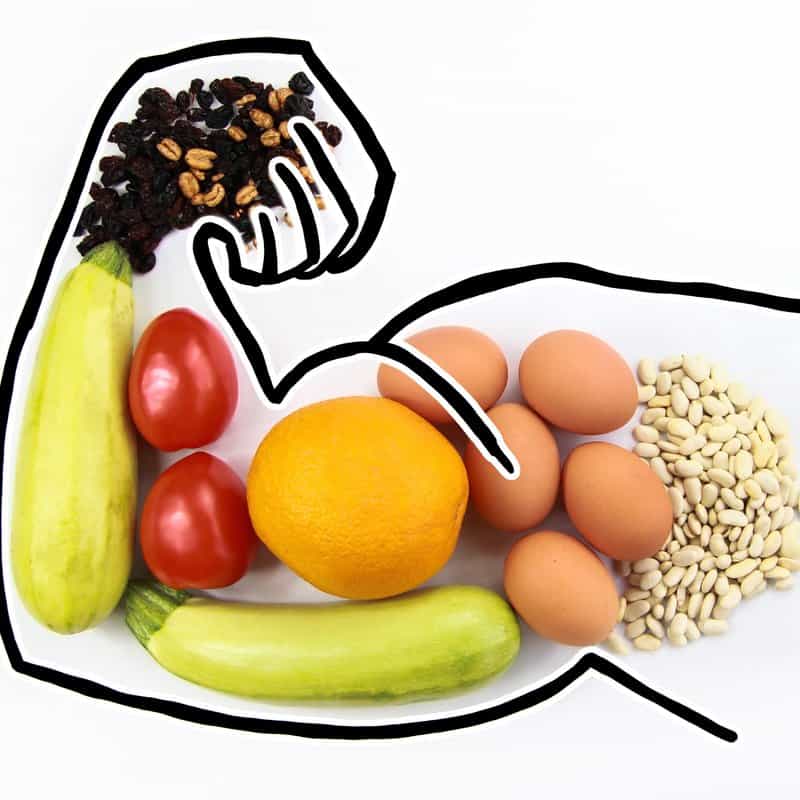This Dr. Axe content is medically reviewed or fact checked to ensure factually accurate information.
With strict editorial sourcing guidelines, we only link to academic research institutions, reputable media sites and, when research is available, medically peer-reviewed studies. Note that the numbers in parentheses (1, 2, etc.) are clickable links to these studies.
The information in our articles is NOT intended to replace a one-on-one relationship with a qualified health care professional and is not intended as medical advice.
This article is based on scientific evidence, written by experts and fact checked by our trained editorial staff. Note that the numbers in parentheses (1, 2, etc.) are clickable links to medically peer-reviewed studies.
Our team includes licensed nutritionists and dietitians, certified health education specialists, as well as certified strength and conditioning specialists, personal trainers and corrective exercise specialists. Our team aims to be not only thorough with its research, but also objective and unbiased.
The information in our articles is NOT intended to replace a one-on-one relationship with a qualified health care professional and is not intended as medical advice.
30 Ways to Help Break Through a Weight Loss Plateau
April 3, 2024

Ah, the dreaded weight loss plateau. You’ve been diligently counting calories, hitting the gym and the scale just…won’t budge.
A weight loss plateau is a period where your body stops losing weight, even though you’re still following your diet and exercise regimen diligently. It’s a frustrating experience that can leave you feeling demotivated and questioning your efforts.
Striving for weight loss can be an arduous journey, filled with ups and downs. One common obstacle many individuals encounter along the way is that dreaded weight loss plateau. This phenomenon occurs when your weight loss stalls despite your continued efforts.
Don’t despair! Plateaus are a normal part of the weight loss journey, and with a few tweaks, you can get that weight loss engine roaring again.
Understanding what causes these plateaus and implementing effective strategies can help you break through and achieve your desired results.
What Is a Weight Loss Plateau?
A weight loss plateau is when your weight stalls despite maintaining your usual diet and exercise routine. It’s frustrating, but it doesn’t mean you’re failing. It simply means your body is adapting and needs a new challenge.
Plateaus can last for days, weeks or even months, making them a significant hurdle for many on their weight loss journeys.
What Causes a Weight Loss Plateau?
Several factors contribute to the onset of a weight loss plateau, including metabolic adaptations, hormonal changes, decreased calorie expenditure and psychological factors, such as stress and lack of sleep.
Additionally, as you lose weight, your body requires fewer calories to function, which can further slow down weight loss progress if adjustments to your diet and exercise routine aren’t made.
Here are some factors that can contribute to a plateau:
- Metabolic Adaptation: As you lose weight, your body becomes more efficient at using calories, burning less overall.
- Muscle Loss: Crash diets or excessive cardio can lead to muscle loss, which lowers your metabolism.
- Inaccurate Tracking: We all underestimate sometimes! Re-evaluate your calorie intake and portion sizes.
- Stress and Sleep: Chronic stress and poor sleep can wreak havoc on hormones that regulate weight.
- Hidden Calorie Creep: Are you mindlessly snacking or indulging in sugary drinks? Every calorie counts.
How to Break a Weight Loss Plateau
Thankfully, there are ways you can overcome a weight loss plateau, though it likely won’t happen overnight. It takes time and dedication, along with a little diligence.
Here are 30 ways to reignite your weight loss journey:
1. Reassess Your Calorie Intake
Track your calorie intake accurately, and adjust as needed to ensure you’re still in a calorie deficit if weight loss is the goal. Slightly reduce your daily calorie intake by 100–200 calories if needed.
2. Mix Up Your Workouts
Incorporate new exercises or increase the intensity of your workouts to challenge your body. If you regularly switch up the types of exercises you do, you can figure out a way to tailor a regimen — cycling through different types of workouts at different times — to your specific needs.
3. Incorporate Strength Training
Build muscle to boost your metabolism. Aim for two to three strength training sessions per week.
Building muscle can help increase your metabolism and improve body composition, making it easier to lose weight. (It’s also an important factor in body recomposition.)
4. HIIT It Up
Incorporate high-intensity interval training (HIIT) for short bursts of intense exercise to burn more calories. As an added bonus, HIIT training can improve “cardiorespiratory fitness” in addition to helping with managing weight even better than moderate-intensity exercise, as shown in research conducted on obese adults.
5. Mix Up Your Cardio
Don’t get stuck in a cardio rut. Try swimming, cycling or dancing for a change.
6. Increase Fiber Intake
Fiber keeps you feeling fuller for longer, reducing cravings. Aim for 25–35 grams daily.
Fiber-rich foods like fruits, vegetables and whole grains can help you reach satiety and aid in weight loss.
7. Increase Protein Intake
Protein helps build muscle and keeps you feeling satisfied. It also helps preserve lean muscle mass and support a healthy metabolism, making it essential for breaking through plateaus.
Include lean protein sources in every meal, such as grass-fed beef, free-range chicken, beans, legumes and more.
8. Stay Hydrated
Drinking plenty of water can help curb appetite, support metabolism and prevent overeating. It’s been shown to be effective in helping with weight loss and possibly aiding in getting over a weight loss plateau.
9. Get Enough Sleep
Aim for seven to nine hours of quality sleep to regulate hormones that influence weight. Better sleep is “associated with greater weight and fat loss,” according to several studies, and “improving and maintaining adequate sleep duration could reduce weight and be a viable intervention for obesity prevention and weight loss programs.”
10. Reduce Stress
Stress can play a role in a weight loss plateau, and a plateau itself can be a stressful event that can affect mental health. Luckily, research shows managing stress can help overcome a weight loss plateau and even improve mood.
Manage stress through yoga, meditation, deep breathing exercises or spending time in nature.
11. Keep a Food Journal and Track Everything
Writing down everything you eat can help you identify patterns and make healthier choices. Keep a food journal to identify hidden calorie culprits. Be honest with yourself!
12. Spice Up Your Life
Chili peppers contain capsaicin, which may enhance metabolism. Spicy foods can help with a plateau as well because they are associated with weight loss.
13. Go Green
Fill your plate with leafy greens for low-calorie, high-nutrient dense meals that support weight loss. Some of the best leafy green vegetables include spinach, kale, watercress and more.
14. Monitor Portion Sizes
Be mindful of portion sizes, even when eating healthy foods, as excess calories can hinder weight loss progress. Use measuring cups and bowls to ensure you’re not overeating, and that includes overindulging on healthy foods.
15. Snack Smartly
Choose healthy snacks like fruits, nuts or veggies with hummus, and avoid packaged snack foods and processed junk. Both snacking wisely (eating healthy foods) and eating unhealthy snacks can affect weight, with healthy snacking leading to better nutrition for weight loss and unhealthy snacking leading to potential weight gain.
16. Cook More Often
Eating out often leads to hidden calorie intake. Cook meals at home for more control on the effect your diet has on your weight.
As an added bonus, “cooking therapy” can be good for your mental health as well.
17. Try Intermittent Fasting
Consider trying intermittent fasting to improve insulin sensitivity and potentially encourage weight loss. (Consult your doctor before starting.) Intermittent fasting can help kick-start weight loss by changing when you eat and promoting fat burning.
18. Detox from Sugar
Added sugars can stall weight loss. Cut back on sugary drinks and processed foods.
19. Take Probiotics
Probiotics may help improve gut health, which can influence weight management. Consider incorporating probiotic yogurt or supplements and other probiotic foods to your routine to help break through a weight loss plateau.
20. Celebrate Non-Scale Victories
Focus on how your clothes fit, your energy levels and overall health, not just the number on the scale. While you may experience a bit of a plateau, recognizing the progress can help you push through the frustration and get back on track.
21. Limit Liquid Calories
Cut back on sugary drinks and alcohol, as they can contribute to weight gain and hinder progress.
22. Eat Whole Foods
Focus on consuming whole, nutrient-dense foods rather than processed snacks and meals. For starters, nutrient-dense foods are typically lower in calories yet very satiating, and they lack added sugars that can make weight loss difficult to achieve.
23. Practice Mindful Eating
Mindful eating has been found to contribute to weight loss and maintenance, and it can even help prevent or curb emotional eating that could be getting in the way of your gains. Pay attention to hunger cues, and eat slowly to prevent overeating.
24. Consider a Refeed Day
Occasionally increasing calorie intake can help reset hormone levels and jump-start weight loss. This is a form of reverse dieting.
25. Limit Cheat Meals
While occasional indulgences are OK, too many cheat meals can sabotage your progress.
26. Experiment with Carb Cycling
Alternating between low- and high-carbohydrate days — aka following a carb cycling diet — can help prevent metabolic adaptation and aid in weight loss.
27. Drink Coffee and Tea
Studies show that caffeine intake may “promote weight, BMI and body fat reduction,” which makes coffee and tea two good options for reversing a weight loss plateau. In fact, both coffee and tea have been associated with fat loss and weight reduction, thanks in part to the caffeine and the antioxidant known as EGCG (epigallocatechin gallate) found in green tea.
28. Stay Consistent
Consistency is key when it comes to breaking through plateaus, so stick to your plan even when progress seems slow.
29. Seek Support
Don’t go it alone! Join a weight loss group, find an accountability buddy or talk to a registered dietitian.
You can also enlist the help of a friend or family member for accountability and encouragement.
30. Be Patient and Persistent
Remember that weight loss is a journey, and plateaus are a natural part of the process. Stay focused on your goals, and trust in your efforts.
Conclusion
- Experiencing a weight loss plateau can be frustrating, but it doesn’t mean you’re doomed to stay stuck forever. By understanding the causes of plateaus and implementing effective strategies like reassessing your calorie intake, mixing up your workouts, and prioritizing sleep and stress management, you can break through and continue making progress toward your weight loss goals.
- Weight loss plateaus are temporary setbacks. By implementing these tips and staying consistent, you can break through the stall and reach your goals.
- Stay committed, stay consistent and remember that perseverance pays off in the end.
- Remember, it’s a marathon, not a sprint. Embrace healthy habits for long-term success!





